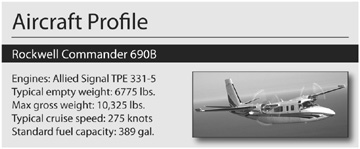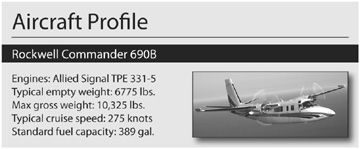by Joseph E. Burnside
On March 27, 2003, at 0113 Eastern time, a Rockwell 690B broke up in flight and was destroyed in the vicinity of Homerville, Ga. Instrument conditions prevailed at the airplanes cruising altitude; an IFR flight plan was filed. The flight originated from Mount Pleasant, Tenn., and was en route to Titusville, Fla.
Communications with ATC were routine until 01:12:10 Eastern time, when a pilot radioed, Mayday, Mayday. There was no other known recorded communications with the airplane.
A review of available data revealed that the airplane was in cruise flight at Flight Level 270 with a 175-knot groundspeed and southeasterly heading at 01:11:41. At 01:11:55, the airplane was at FL266 in a left turn at a groundspeed of 200 knots. At 01:11:57, the airplane was at FL257 and 200 knots. At 01:12:04, the airplane was heading northeast at FL232 and 245 knots. At 01:12:10, the airspeed was 275 knots. The last radar return was at 01:12:16, and the airplane was at 16,500 feet with a 299-knot groundspeed.Later that morning, local law enforcement personnel located the airplane wreckage. The ATP-rated pilot and the sole passenger were fatally injured.
Weather Observations
Weather in the area of the crash on the day of the flight was fairly typical for the southeast in March. A low-pressure area was situated in the Gulf of Mexico south of Louisiana with a frontal wave. A stationary front was depicted extending northeast from the low front across the Florida panhandle into southeast Alabama and into central Georgia before turning into a cold front across South Carolina, North Carolina and off the Atlantic Coast. A cold front extended to the south of the low-pressure system with a trough of low pressure to the east, which extended into northern Florida. Ahead of the cold front and south of the stationary front, a squall line was depicted in the Gulf of Mexico off Floridas west coast. The accident site was located south of the stationary front and downstream of the low-pressure system.

The constant pressure charts for 1900 on March 26, 2003, depicted two defined jet streams with wind in excess of 50 knots north and south of the accident site, with the accident site in the confluence region between the two systems. The subtropical jet stream was depicted over central Florida to the south of the accident site with indicated winds of 125 knots at 30,000 feet, which resulted in an approximately 60 knots per 150-mile horizontal wind shear from the accident site to the maximum wind across central Florida.
The Upper Air Data sounding for Jacksonville, Fla., at 1900 on March 26, 2003, at 27,000 feet, showed winds increasing rapidly above 30,000 feet, with several layers of vertical wind shears greater than five knots per 1000 feet, which are associated with severe turbulence. At 31,000 feet there was a 100-percent probability of severe turbulence. The 1900 Upper Air Sounding for Jacksonville showed at 24,100 feet a 100 percent probability of severe turbulence.
There were no pilot reports (Pireps) recorded over Georgia between 1900 to 0700 in the FAA database. After 0900 there were several reports of light to moderate turbulence reported between FL330 to FL350, and one isolated report of moderate to severe turbulence at 7000 feet over Georgia. A Boeing 727 pilot who was in the vicinity of the accident flight stated he was at FL310 in IMC with light chop and possible light rime icing when he heard the initial Mayday call. He was asked by the controller to descend to FL270 feet and attempt to contact the accident airplane. The 727 pilot was unable to contact the accident airplane. He remained in instrument flight conditions with the same approximate flight conditions.
The NTSBs review of in-flight weather advisories revealed there were no areas of organized turbulence forecasted.
The pilot used a Duat session to file an IFR from Mount Pleasant, Tenn., to Titusville, Fla. The pilot listed himself as pilot, checked Notams and terminated the Duat briefing at 12:39:53. No en route weather information was requested during the Duat sessions. There was no record of the accident pilot contacting any FAA Automated Flight Service Station to receive a formal weather briefing.
Investigation
The Airline Transport Pilot had logged 3569.4 hours of which 35.6 were in the Rockwell 690B. The pilots first recorded flight in the Rockwell 690B was on October 21, 2002; the pilot had flown the aircraft an additional 10.2 hours between March 7, 2003, and March 23, 2003.
The aircraft had no recorded accident or incident history. The year before, its engines had been upgraded to the more powerful Dash 10 configuration. The pitot system check and transponder inspection was conducted on April 4, 2002, and the airplane had accumulated some 150 hours total time since the engine refurbishment.
The crash debris was oriented on a magnetic heading of 024 and extended for 8081 feet. The left and right elevators were located 2351 feet down the debris line and 3233 feet to the left. The left outboard wing section was located 4235 feet down the debris line and 16 feet to the right. The vertical stabilizer was located 5839 feet down the debris line and 127 feet to the left of the debris line.
Continuity was confirmed from the broken rudder cable arms to aft of the cabin area. Continuity was also established from both flight control yokes to the aileron master bellcrank aft of the cabin area, and elevator control cable continuity was confirmed from the elevator bellcrank, also to the aft cabin area.The elevator control torque tubes were separated between the control columns and the elevator control bellcrank.
The right wing spar upper cap was attached to the wing root, and the right wing was displaced aft. The upper spar cap was bent downward 24 inches outboard of the aircraft centerline. The right wing outboard of the right engine nacelle was bent upward. The left wing was attached to the wing root, and was displaced forward. The leading edge of the left inboard wing sustained wrinkling one foot outboard of the wing root, and a dent in the leading edge with aft crushing was noted 4 feet outboard of the wing root.The left aileron was not recovered. There were no major discrepancies with either engine.
Two pieces of the left wing, two pieces of the right wing, a piece of fuselage skin, upper and lower pieces of the vertical stabilizer, a piece of rudder, a piece of the left horizontal stabilizer, and a piece of the right horizontal stabilizer were submitted to the NTSB Materials Laboratory for further examination. All fracture surfaces were overstress fractures.
There was no evidence of preexisting cracking or fatigue observed on any fracture surface. Fracture surfaces that were not damaged generally appeared matte gray and were on slant planes. The left wing, and left and right horizontal stabilizer fractured in downward bending. The right wing fractured in upward bending. The vertical stabilizer fractured from the fuselage with the leading edge moving upward relative to the fuselage. The rudder tip fractured moving to the left and aft relative to the rudder.
A number of placards and warnings about flying in turbulence are included in the airplanes Pilots Operating Handbook. Among them is this note: Since a finite period of time is required to reduce speed from the onset of turbulence, a speed reduction should be accomplished in anticipation of suspected turbulence, whenever possible.
Conclusions
The NTSB found the probable cause of this accident, in part, to be An in-flight encounter with unforecasted severe turbulence in cruise flight resulting in the design limits of the airplane being exceeded due to an overload failure of the airframe.
Its easy to look at the lack of an explicit turbulence warning for pilots flying in this area and blame forecasters for this accident. But, the clues that turbulence was present in the area were there.Whether the pilot could have seen and recognized these clues for what they were if he had obtained a full weather briefing or used his Duat session to look more closely at the en route weather is anyones guess.
But even a cursory examination of the weather patterns, high winds at altitude and the unpredictable nature of springtime weather should have merited the pilot taking a closer look at the en route weather he was about to face.
Once a complete briefing is obtained, we need to fly the airplane in a fashion that anticipates what was in the forecast. In this instance, that wasnt possible, since the pilot never obtained a full weather briefing. With an extra five minutes at the Duat terminal, the outcome could have been much different.




